DHL Express, which provides international courier, parcel, and express mail services, is targeting the use of delivery barges on the Thames this year, as part of its “go green” strategy.
Freight takes up almost one-third of all morning rush hour road traffic in the capital – vans responsible for carrying about 80%. A study by Transport for London (TfL) says that vans are the only motorised form of transport forecast to grow in London, which will make an already untenable situation worse. Safety is one of the main reasons for improving London’s freight transport, with HGVs involved in more than 70% of deaths involving cyclists.
Chief executive John Pearson confirmed to The Loadstar that the company’s UK division was working on a scheme similar to that in Amsterdam (pictured below) where DHL Express transports parcels along the canals of Amsterdam and uses its electric cycles for the ‘last mile’. While delivery vans are struggling through the city’s narrow streets, the DHL boat just ‘goes with the flow’.
This solution is not only more environmentally friendly, but – all things considered – is much more efficient as well.
 Mr Pearson said, “Over the past three or four months, Paul Hampson, UK operations director and the team have been moving stuff up and down the Thames. From there the packages would be put onto bikes to get to their final destination in the wider city.” The pilot programme with the barges is also hoping to use its electric ‘cubicycle’ – a customized cargo bicycle which can carry a container with a load of up to 125 kg.
Mr Pearson said, “Over the past three or four months, Paul Hampson, UK operations director and the team have been moving stuff up and down the Thames. From there the packages would be put onto bikes to get to their final destination in the wider city.” The pilot programme with the barges is also hoping to use its electric ‘cubicycle’ – a customized cargo bicycle which can carry a container with a load of up to 125 kg.
A DHL spokesperson said, “Providing the pilot goes successfully, we are targeting roll-out of the barge system at some point in 2019. We would be using it to move documents and small packages along the main body of the Thames but at the moment are not considering using the canals.”
London mayor Sadiq Khan wants to see about 55% of all project materials carried by river, as well as an overall increase in the amount of freight carried this way. City government efforts are reaping some rewards, with TfL noting that a number of barge trials had been undertaken to increase load-bearing from 800 tonnes to 1,500 tonnes. TfL also uses its influence to indicate transport modes for the projects it is involved in building.
Use of the Thames as a working river is gaining traction once again. TfL’s freight and fleet project manager, Peter Binham, said: “More than 7m tonnes of cargo are being moved by barge in the development of the Tideway sewerage system. This presents the perfect opportunity to demonstrate the Thames’s capacity for use as a freight route.”
o




Pingback: Thames and Humber Freeports can use greener supply chains: inland waterways | Inland Waterway Freight